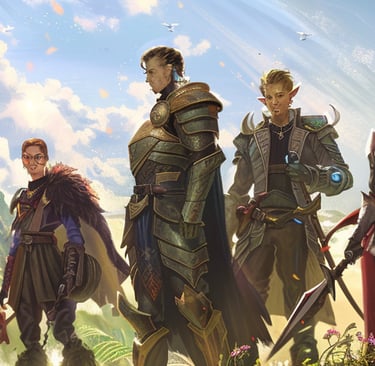Beyond Binary: Introducing Gender Fluidity in Fantasy Worlds
Embracing the Spectrum: Crafting Enriched and Inclusive Fantasy Narratives
DIVERSITYWRITINGWORLD BUILDING
Kat Sanders
3/6/202417 min read


Picture a world where magic is real, dragons soar in the skies, and heroes go on epic adventures. Now, imagine that in this magical world, people can be whoever they want to be, beyond just 'boy' or 'girl'. This is where the idea of gender fluidity comes into play.
What is Gender Fluidity?
Gender fluidity is when a person's sense of their gender changes over time. One day, they might feel more like a boy; another day, they might feel more like a girl; and some days, they might not feel like either. It's all about what feels right to them at that moment.
This concept might sound modern, but it's been around for a very long time, popping up in stories and myths from all over the world. In fantasy worlds, where anything is possible, gender fluidity can add an extra layer of magic and possibility.
Why Does It Matter in Fantasy Worlds?
When we read fantasy books or watch fantasy movies, we're diving into worlds full of imagination. But even in these fantastic places, it's important that everyone can see themselves. That's where diverse representation comes in. It means including all kinds of people, with different backgrounds, appearances, and, yes, genders.
Think about your favorite fantasy stories. Now imagine if they included characters who could change their gender, just like they might change their clothes or their hairstyle. It makes the world richer and more interesting, right? Plus, it can make people who are gender fluid feel seen and understood, which is super important.
Fantasy and Gender Fluidity
In this journey through fantasy and gender fluidity, we're going to explore how writers can include gender fluid characters in their stories. We'll dive into what gender fluidity means and how it's shown up in history and myth. We'll share tips on creating worlds that welcome all types of people and how to make characters that everyone can relate to.
We'll also look at how these characters can fit into the story, making it even more exciting and meaningful. And because we know that writing about new things can be tricky, we'll talk about how to handle challenges that might pop up.
By the end of our adventure, you'll have a treasure chest full of ideas for bringing gender fluidity into your fantasy worlds. So, let's set sail into this magical realm and discover how we can make our fantasy worlds welcoming for everyone!


Understanding Gender Fluidity
In the magical realm of fantasy, characters, creatures, and the very lands they inhabit often defy the ordinary. But what about defying the traditional ideas of gender? Here's where understanding gender fluidity becomes essential.
Defining Gender Fluidity
Imagine waking up each day and deciding who you want to be. For some, it's choosing an outfit; for others, it's feeling more like a boy some days, more like a girl on others, or maybe even somewhere in between. This is the essence of gender fluidity. Unlike being strictly male or female all the time, gender fluid individuals experience a range of gender expressions and identities over time.
This concept differs from other gender identities in its variability. While someone who is transgender transitions from the gender assigned at birth to their true gender, a gender fluid person's identity may change over days, months, or years. It's important to understand this distinction to create more inclusive and representative fantasy worlds.
Mythology and History: Gender Fluidity Through the Ages
The roots of gender fluidity stretch far back into history and mythology, where gods, goddesses, and heroes often transcended human gender norms. Take, for example, the Ancient Greek god Hermes and the goddess Aphrodite, who together birthed Hermaphroditus, a being embodying both male and female qualities. Or consider the Norse god Loki, who could change shape and gender at will.
These myths show us that the idea of more than two genders isn't new but a part of human culture and storytelling for millennia. By exploring these ancient beliefs, modern fantasy can find rich ground for characters who break the binary mold, reminding us that the spectrum of gender is as wide and varied as the spectrum of human imagination.
The Value of Representation: Seeing Ourselves in Fantasy Worlds
Why does it matter to see gender fluid characters in fantasy realms? Because stories are mirrors and windows. They reflect our world back to us, showing us who we are, and they also give us a view into other lives, helping us understand and empathize with different experiences.
When fantasy worlds reflect the diversity of the real world, including the variety of gender experiences, they become richer and more engaging. Including gender fluid characters can challenge readers to think beyond traditional roles and stereotypes, opening the door to new stories and possibilities.
Moreover, for gender fluid readers, seeing themselves in these fantastical narratives can be affirming and empowering. It tells them that they are not alone, that they too belong in the grand adventures and epic tales, just as much as anyone else.
Understanding gender fluidity is not just about adding another type of character to the mix. It's about opening our minds to the full spectrum of human experience. It's about making fantasy realms that are as diverse and fascinating as the people who dream of them. In doing so, we make our stories richer, more inclusive, and infinitely more interesting.


World-Building with Gender Fluidity
When crafting a fantasy world, the canvas is as broad as your imagination. One of the joys and responsibilities of world-building is shaping societies that are not only diverse but also inclusive. Here's how you can weave gender fluidity into the very fabric of your fantasy realms.
Crafting Inclusive Societies
Inclusive societies in fantasy settings are those where all characters, including those who are gender fluid, feel welcome and respected. Start by imagining cultures that celebrate gender diversity as a natural part of life. Maybe in your world, there's a festival that honors a deity embodying multiple genders, or perhaps there are respected roles in society specifically for gender fluid individuals, like mediators or storytellers.
Think about family structures, social roles, and daily life. How might these differ in a society that doesn't enforce a strict gender binary? Maybe inheritance isn't passed down by male lineage but by the eldest, regardless of gender. Or perhaps titles and ranks are not gender-specific but based on merit, magic, or other factors. Creating these aspects of your society can help readers imagine a world where gender fluidity is accepted and embraced.
Magic and Mythology: Blending Gender Fluidity into Your World's Fabric
Magic and mythology offer powerful tools for incorporating gender fluidity. Perhaps in your world, magic itself is genderless, or it manifests differently based on the wielder's current gender expression. Consider deities that embody multiple genders or none at all, reflecting the fluidity and breadth of human (and divine) experience.
Myths can serve as historical precedents in your world, showing that gender fluidity has always been a part of this universe's fabric. These stories can help characters and readers understand and accept gender fluidity as a natural aspect of the world.
Language and Norms: Reflecting Diversity through Words and Actions
Language shapes reality, especially in fantasy worlds. Developing in-world language that reflects gender diversity can significantly impact how characters interact and how readers perceive your world. Consider creating gender-neutral pronouns or titles for your characters, or perhaps invent new terms that characters use to describe their gender experiences.
Social norms, from clothing to courtesies, offer another layer to your world-building. Imagine a society where clothing is not gendered, where people dress as they feel best represents them on any given day, or where traditional greetings include stating one's current pronouns.
Additionally, consider legal and social structures that support gender diversity. Laws that protect individuals from discrimination based on gender expression, or cultural rituals that celebrate an individual's journey to understand their gender, can deepen the reader's understanding of your world's values.
By integrating gender fluidity into the societies, magic, mythology, language, and norms of your fantasy world, you create a richer, more nuanced setting. Not only does this make your world more interesting and believable, but it also offers a space where readers of all gender identities can see themselves reflected and respected. This approach to world-building not only entertains but enlightens, paving the way for a more inclusive and imaginative fantasy landscape.


Developing Gender Fluid Characters in Fantasy
In the tapestry of fantasy storytelling, characters bring the vibrant colors and patterns to life. When these characters include gender fluid individuals, the story gains layers of depth and authenticity. Here’s how to craft gender fluid characters that resonate with truth and add dimension to your fantasy realms.
Creating Authentic Characters
Authenticity starts with character depth. Gender fluid characters, like all characters, should have their own desires, fears, strengths, and flaws. Their gender identity is an aspect of who they are but not their sole defining feature. To develop a well-rounded gender fluid character, think about their background, their role in the story, and how their gender fluidity influences but does not solely define their experiences and perspectives.
Consider their journey: Have they always embraced their gender fluidity, or is it a recent discovery? How do they navigate their world? What challenges do they face, and what victories do they celebrate? Embedding these characters in your world’s culture, politics, and conflicts makes them integral to the narrative, not just tokens of diversity.
Avoiding Stereotypes
To avoid clichés, step away from using gender fluidity as the source of a character’s turmoil or the sole plot point. Instead, let their challenges and growth be as multifaceted as they are. Remember, gender fluid characters can fulfill any role in your story – from the wise mentor to the fearless warrior, from the cunning villain to the compassionate leader.
Be mindful of not falling into the trap of making your gender fluid characters mysterious or exotic simply because of their gender. They should be as real and relatable as any other character, with goals and relationships that contribute to the story in meaningful ways.
Research and sensitivity reads can help avoid stereotypes and ensure respectful representation. Listening to the experiences of gender fluid people and incorporating their realities into your characters can enrich your storytelling.
Pronouns and Identity: Handling with Care
In a fantasy context, you have creative freedom to explore how pronouns and identity are expressed in different cultures and societies. Your world might have specific norms around pronouns, or perhaps magical elements that allow a character’s physical appearance to change with their gender identity. However, it’s crucial to handle these aspects thoughtfully.
Consistency is key when dealing with pronouns – if a character’s pronouns change, ensure the change is clear to the reader and respectful of the character’s identity. You might also introduce a system within your world that accommodates or even celebrates fluid pronouns, providing a model for inclusivity.
When introducing gender fluid characters, consider how they communicate their identity to others, and how those around them respond. These interactions can offer insights into the societal norms of your world and the individual personalities within it.
Incorporating gender fluid characters in fantasy settings opens up a world of narrative possibilities. By crafting these characters with depth, steering clear of stereotypes, and thoughtfully handling pronouns and identity, you create a more inclusive and engaging fantasy world that reflects the diversity of human experience. This not only enriches your storytelling but also provides a space for all readers to see themselves in the magic of your creation.










Case Studies and Inspiration
The landscape of fantasy literature and media is vast, offering endless opportunities for exploring the complexities of identity, including gender fluidity. By examining successful examples of gender fluid characters in these realms, we can uncover what makes them resonate with audiences and how they contribute to the genre's evolution.
Successful Examples in Fantasy Literature and Media
One notable example is the character of Loki from Norse mythology, reimagined in various contemporary forms, including comics and television series. Loki, traditionally a shape-shifter and trickster, transcends conventional gender boundaries, embodying both male and female forms across different stories. This fluidity adds depth to Loki's character, making them unpredictable and multifaceted, which is central to their appeal and mystique.
Another impactful representation is the character of Desire from Neil Gaiman's "The Sandman" series. As one of the Endless, Desire is neither male nor female but embodies both, challenging traditional gender norms and highlighting the fluid nature of desire itself. The character's ambiguity and complexity make them one of the most intriguing figures in the series, showcasing the potential of non-binary representation in fantasy narratives.
In "The Left Hand of Darkness" by Ursula K. Le Guin, the inhabitants of the planet Gethen are androgynous, becoming male or female during their mating cycle. This unique approach to gender not only serves as a central theme of the novel but also prompts readers to reconsider their own perceptions of gender and sexuality. Le Guin's exploration of fluidity and ambiguity has left a lasting impact on science fiction and fantasy, encouraging deeper thought and discussion among readers.
Impact of These Representations
What makes these representations impactful is their ability to challenge and expand our understanding of gender. By presenting gender fluid characters not as anomalies but as integral parts of their respective worlds, these works promote a broader acceptance of different gender identities. They allow readers to question and rethink societal norms, providing a space for reflection and empathy.
Moreover, these characters often play crucial roles in their narratives, proving that their gender identity is not just a side note but a significant aspect of their character arc and the story's development. This inclusion enriches the narrative, providing a more comprehensive and diverse portrayal of the world.
Drawing Inspiration from Folklore, Mythology, and Contemporary Works
When creating gender fluid characters, look beyond contemporary examples and delve into folklore and mythology. Many cultures have tales of gods, spirits, and mortals who defy gender norms, embodying traits of both sexes or changing gender at will. These stories offer a wealth of ideas for character development, magical abilities, and cultural attitudes toward gender.
Contemporary works, too, offer a treasure trove of inspiration. Authors and creators who thoughtfully explore gender fluidity in their stories can provide insights into crafting believable, relatable characters. Analyzing how these characters navigate their worlds, form relationships, and confront challenges can help in developing your own complex, compelling narratives.
Incorporating gender fluid characters inspired by these examples can bring a refreshing depth to fantasy worlds, inviting readers to explore the endless possibilities beyond the binary. By learning from successful representations and drawing on the rich tapestry of human culture and imagination, writers can contribute to a more inclusive, diverse, and fascinating fantasy genre.
Resources for Fantasy Writers
Incorporating gender fluid characters into fantasy worlds can be a rewarding journey, offering new dimensions to explore in storytelling. However, it’s a path best navigated with resources, support, and continuous learning. Here are some valuable tools and communities to assist fantasy writers in embracing gender fluidity in their narratives.
Writing Resources and Guides
"Writing the Other" by Nisi Shawl and Cynthia Ward: This guide offers insights into writing characters very different from yourself, addressing aspects of race, sexuality, and gender, including gender fluidity.
Lambda Literary: An organization dedicated to promoting LGBTQ literature, offering workshops, resources, and writing retreats that can help understand and portray gender fluid characters.
The Gender Spectrum Collection by Vice: A free-to-use library of stock photos featuring trans and non-binary models that can help writers visualize gender fluid characters in realistic settings.
Online articles and blogs: There are numerous articles online specifically addressing the creation of non-binary and gender fluid characters. Websites like Everyday Feminism and Writing Cooperative often feature relevant articles and advice.
Communities, Workshops, and Forums
Absolute Write Water Cooler: An online forum where writers can discuss and seek feedback on various writing topics, including diversity and representation.
Scribophile: An online writing group for serious writers where you can share your work for critique, including chapters or characters that involve gender fluidity.
Queer Sci Fi (QSF): A community for writers and fans of LGBTQ+ science fiction and fantasy, offering a space for discussion, feedback, and support.
Writing With Color Tumblr: A platform dedicated to writing and resources centered on racial and cultural diversity, but also touches on gender diversity.
National Novel Writing Month (NaNoWriMo) Forums: During NaNoWriMo, writers from all over the world come together to write a novel in a month. Their forums provide a great place to discuss and seek advice on including diverse characters.
Tips for Continuous Learning
Educate Yourself: Regularly read books, articles, and studies about gender fluidity and the wider spectrum of gender identity. The more you understand, the better you can represent gender fluid characters.
Engage with the Community: If possible, engage directly with gender fluid individuals or communities. Listen to their stories and perspectives to gain deeper insights into their experiences.
Seek Feedback: When you’ve written gender fluid characters, seek feedback from readers who understand gender fluidity, whether they identify as gender fluid themselves or are allies knowledgeable about the subject.
Be Open to Criticism: Not all feedback will be positive, but all of it can be valuable. Be open to criticism and use it to improve your understanding and representation of gender fluid characters.
Reflect Diversity in Your Reading: Consume a diverse range of stories by authors of different backgrounds, including those who identify as non-binary or gender fluid. This will not only improve your understanding but also support diverse voices in literature.
By utilizing these resources, communities, and continuous learning practices, fantasy writers can enrich their narratives with authentic, respectful, and engaging representations of gender fluid characters, contributing to a more inclusive and diverse fantasy literature landscape.
Overcoming Challenges in Writing Gender Fluid Characters
Writing gender fluid characters in fantasy settings offers a unique opportunity to explore the complexities of identity and expression. However, this journey is not without its hurdles. By understanding and addressing common challenges and misconceptions, writers can navigate these waters more effectively and create more inclusive, respectful narratives.
Common Challenges and Misconceptions
One of the primary challenges is the lack of understanding or awareness about gender fluidity. This can lead to stereotypes, clichés, and oversimplifications, diminishing the authenticity and depth of your characters. To counter this, thorough research and engagement with gender fluid communities can provide valuable insights and help avoid misrepresentation.
Another common challenge is balancing the character’s gender fluidity with other aspects of their identity. It's crucial to remember that gender fluidity is just one part of who they are. Avoid making their gender the sole focus of their character arc or reducing them to a token within the story.
Writers may also encounter misconceptions that gender fluid characters do not fit within fantasy genres or that their inclusion is simply pandering to a trend. Addressing this requires a firm understanding of the genre’s history of exploring identity and transformation and highlighting how gender fluid characters enrich the narrative and deepen world-building.
Dealing with Backlash and Constructive Criticism
Backlash can come from various sources, including readers, publishers, or online communities. It’s important to differentiate between constructive criticism and outright hostility. Constructive feedback can help refine your portrayal of gender fluid characters, making them more nuanced and authentic.
When facing backlash, stay informed and confident in your reasons for including gender fluid characters. Engage respectfully with critics when possible, but also recognize when a dialogue is unlikely to be productive. Surround yourself with a supportive community of writers and readers who value diversity in storytelling.
Legal and Cultural Considerations
Understanding the legal and cultural landscape is crucial, especially when publishing internationally. Different countries and communities have varying degrees of acceptance and legal protections for gender-diverse individuals. Familiarizing yourself with these nuances can help in crafting stories that are both respectful and accessible to a global audience.
Additionally, consider the cultural implications within your fantasy world. How does this society view gender fluidity? What laws or customs exist that affect gender fluid characters? Integrating these elements thoughtfully can add depth to your world and provide a richer backdrop for your characters’ journeys.
Writing gender fluid characters is an ongoing learning process. It requires empathy, research, and a willingness to listen and adapt. While challenges exist, the potential for storytelling and the opportunity to contribute to a more inclusive and diverse fantasy landscape are immense.
By approaching these challenges with care and consideration, writers can create worlds that not only entertain but also reflect and celebrate the rich tapestry of human identity. In doing so, they open doors to new perspectives and experiences, enriching the genre and its readership.
In the realm of fantasy storytelling, the inclusion of gender fluid characters holds the power to not only transform narratives but also to broaden the horizons of readers worldwide. By weaving the rich tapestry of gender diversity into the fabric of fantasy worlds, writers have the unique opportunity to challenge conventional norms and invite readers into more inclusive, vibrant landscapes where everyone can find a reflection of themselves.
The journey of integrating gender fluidity into fantasy is not merely about adding characters; it's about enriching the narrative soil with the depth and variety of human experience. By doing so, writers can craft worlds that resonate more deeply with a wider audience, fostering empathy and understanding across a spectrum of identities.
Moreover, the evolution of fantasy literature to include diverse and authentic representations of gender is a testament to the genre's enduring power to explore the boundless possibilities of the human condition. As writers, embracing this evolution means stepping into a role that is not just about entertainment but also about enlightenment and reflection.
In this ever-changing world, the stories we tell are more important than ever. Let us, as creators and storytellers, commit to expanding our worlds beyond the binary, to exploring the vast expanse of identity and expression, and to making fantasy a realm where every reader can find magic that speaks to them. The future of fantasy literature shines brighter with each story that dares to imagine a world as diverse and fluid as the reality that inspires it.
Plot and Conflict: Gender Fluidity in Action
In the realm of fantasy storytelling, every character plays a crucial role, embarking on journeys that shape the world around them. Gender fluid characters, with their unique perspectives, can add compelling layers to your narrative, challenging conventions and engaging your audience in new ways.
Narrative Roles
Gender fluid characters can inhabit any role within your fantasy story, from the main hero embarking on an epic quest to the wise sage offering guidance, or even the formidable antagonist presenting challenges to the protagonists. The key is to allow their gender fluidity to enhance their narrative role without being the sole focus of their character. For instance, a gender fluid mage might draw on different aspects of their identity to channel varied magical powers, or a shape-shifting spy could adapt their appearance and role in society fluidly, serving as a bridge between different worlds or factions.
Conflicts and Challenges
Integrating a character's gender fluidity into the story’s conflicts and challenges can add depth to both the character and the plot. Their journey could involve personal acceptance, societal recognition, or the challenge of living authentically in a world that may not always understand them. However, these should not be their only challenges.
Consider how their gender fluidity might uniquely position them to solve problems, negotiate peace, or uncover secrets. Perhaps their fluid perspective allows them to see solutions others cannot, or their ability to navigate different social environments makes them invaluable in diplomatic situations. Their personal growth and the external conflicts they face should intertwine, allowing their identity to play a role in their journey without defining their every challenge.
Subverting Tropes
Fantasy is filled with well-worn tropes and conventions, but gender fluid characters offer a fresh lens through which to view these elements. They can subvert traditional expectations, such as the destined hero, the love triangle, or the mentor-apprentice dynamic, by bringing new dynamics based on their fluid identities.
For example, a gender fluid character might challenge the notion of a "chosen one" who is supposed to fit a specific gendered prophecy. Their existence could call into question the rigid structures of fantasy societies, from lineage and inheritance to the division of magical abilities. In romance subplots, their fluidity can explore more diverse relationships and emotional experiences, moving beyond the typical binary love interests.
Incorporating gender fluid characters into your fantasy plots offers a unique opportunity to rethink and reshape familiar narratives. By giving these characters meaningful roles, integrating their identities into the story’s conflicts, and using them to challenge and enrich traditional tropes, you can create a richer, more inclusive fantasy world. This approach not only broadens the appeal of your story but also deepens the engagement of your audience, inviting readers to explore new perspectives and imagine beyond the boundaries of the conventional.
